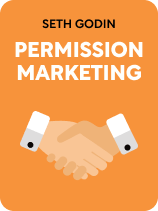

This article is an excerpt from the Shortform book guide to "Permission Marketing" by Seth Godin. Shortform has the world's best summaries and analyses of books you should be reading.
Like this article? Sign up for a free trial here.
How important is trust in marketing? How can you concretely build it and keep it?
In Permission Marketing, Seth Godin discusses two approaches: Interruption Marketing and Permission Marketing. Both owe their profitability to the fact that they built customer trust in a brand. However, Godin asserts that Permission Marketing builds trust in a far more cost-effective way.
Read more to learn about building customer trust through Godin’s permission model.
Trust in Marketing
Godin discusses the importance of trust in marketing and shares practical ways to build it by pitching your brand and choosing a business model that’s based on trust.
Godin explains that Permission Marketing materials don’t require as many repeated viewings as Interruption Marketing does to build familiarity with your brand. Since consumers requested the advertisements, they’ll pay attention to and digest them the very first time they receive them.
Likewise, since the prospective customer has already agreed to pay attention to your message, you don’t have to be as showy and can pitch your product or service’s benefits much more thoroughly than you could in Interruption Marketing. You can directly convince consumers that your brand is reliable, building the same kind of brand trust that Interruption Marketing does but much more efficiently. Since customers tend to buy from brands they trust, this often results in a swift increase in sales.
Build Trust by Pitching Your Product or Service
After you secure permission to contact consumers directly, your goal is to use that communication channel to build their trust in your brand. Godin suggests sending consumers a series of marketing messages that convey specifically how your brand will improve their life.
(Shortform note: Arguably, the marketing messages you send at this stage have more of an impact on customer satisfaction than the product itself. In his 2005 book All Marketers Are Liars, Godin argues if you tell a story about how your product can radically improve someone’s life, and your customer believes that story, it becomes true. This is because the customer’s perception of your product is largely subjective. For instance, imagine you hand-carve flutes out of a rare type of balsa wood. If you emphasize in your marketing emails that this will help customers create beautiful music unlike any other type of flute, customers may prefer how your instrument sounds even if it’s not objectively “better.”)
Make sure consumers don’t lose interest in these messages, Godin notes. Each one should provide enough value (such as entertainment or useful information) to retain their attention. If consumers need more encouragement, provide additional freebies as necessary to keep them engaged.
(Shortform note: For how long do you need to keep consumers interested and engaged in your emails before they’ll actually buy your product or service? Marketers answer this question with the “Rule of Seven,” which states that customers will typically engage with your brand seven times before they’re prepared to make a purchase. Thus, you may need to spend more on creating valuable emails and promotional freebies than you initially expect—they won’t start paying off until you engage a consumer seven times.)
Establish a Trust-Based Business Model
Once consumers strongly believe that your brand can improve their lives, you unlock a number of profitable business models that function only after you’ve earned consumer trust. Here are three options for trust-based business models with the potential to turn your company into a wild success.
Option #1: Sign Customers Up for a Subscription
According to Godin, the most valuable form of permission you can get is to charge the customer for goods and services you know they want, without them giving specific permission for each purchase—typically, this takes the form of a recurring subscription payment. If consumers trust that you understand what they want and can reliably give it to them, they’ll gladly pay you to buy things for them to avoid wasting time doing it themselves. All permission marketers should aspire to achieve this level of permission since it’s the most profitable.
| How to Create a Habit-Forming Subscription If you’ve built brand trust and your product or service still isn’t attracting subscribers, what can you do? According to Nir Eyal (Hooked), subscription models only succeed when you successfully influence consumers into making a regular habit out of using your product or service. For example, your subscription-based meal delivery service will be a failure unless you somehow get the customer to regularly get food delivered, justifying the recurring expense. Eyal contends that you can make your subscription-based product or service a habit by designing it to be constantly surprising. Contrary to what Godin claims, consumers by default prefer to make purchases for themselves. Thus, consumers will often cancel their subscriptions after the initial novelty of having someone else choose what they buy fades away. However, if you constantly refresh this feeling of novelty, consumers will make a habit out of your subscription to keep that feeling. One way to achieve this perpetual novelty is to create a product or service that learns and improves as subscribers use it, like an app on your phone that tracks the food you eat and learns to suggest personalized daily meal schedules. |
Option #2: Implement a Rewards Program
If you can’t establish a subscription model, the next most valuable form of permission you can get is permission to influence consumers’ behavior in exchange for points that earn them free rewards. Godin recommends offering points for every purchase as well as for actions that increase the likelihood of future purchases—for instance, a customer engaging with a branded message to learn more about your product or service.
Rewards programs increase profits by incentivizing consumers to purchase from your brand more frequently than they otherwise would have—in other words, by bribing people to become loyal customers. With this in mind, Godin recommends a specific way to structure your rewards: To ensure that only customers who are truly loyal to your brand get rewarded, make your points worthless if consumers interact with your brand once or twice but pay off if they become regular customers. That way, you only invest money in already-profitable customers.
| Counterpoint: Rewards Programs Don’t Work In How Brands Grow, Byron Sharp contends that offering a rewards program is one of the most common mistakes that marketers make, as these programs’ profits fail to reliably outweigh their cost. Consulting purchasing data from businesses across a wide range of industries, Sharp finds that the members of a brand’s rewards program don’t purchase from that brand any more frequently than customers who aren’t members. Thus, these programs largely offer discounts and rewards to consumers who would have purchased from the brand anyway, making those rewards a waste of money. Seen through this lens, Godin’s recommended rewards structure may backfire. The system assumes that customers deserve massive rewards if they become your most loyal customers. But if those customers would have become your most loyal customers anyway, you may be undercutting the revenue you get from what should be your most profitable customers. |
Option #3: Sell High-Ticket Items Personally
Finally, another option for establishing a profitable, trust-based business model is to reach out, set up meetings with individual consumers, and get to know them personally. If someone trusts you on a personal level, you can get them to invest much more in you and your brand than if you contacted them through an impersonal system. That said, Godin acknowledges that the utility of this business model is limited since it requires significant personal attention that you can’t provide to a wide customer base. Thus, use only personal trust to sell expensive goods and services that provide enough revenue to justify your prolonged personal time and attention.
| Build Trust Through Authenticity In Start With Why, Simon Sinek further explains how to earn the trust of others on a personal level: Demonstrate that you share a purpose with them. Sinek argues that trust is an instinctive feeling generated deep in the brain’s emotional center, the limbic system, when a person sees you as part of the same group as them. For this reason, you can’t build trust by appealing logically to a potential customer—for instance, by emphasizing how many satisfied customers you’ve had. Sinek doesn’t specifically discuss one-on-one sales, but you can still apply his ideas regarding trust to this strategy. Target potential customers who share the purpose, cause, or central belief behind your business, and authentically communicate it while making the sale. For example, if you’re trying to sell solar panels to large corporate offices, contact the leaders of environmentally conscious businesses and emphasize your shared mission of sustainability when meeting with them. |

———End of Preview———
Like what you just read? Read the rest of the world's best book summary and analysis of Seth Godin's "Permission Marketing" at Shortform.
Here's what you'll find in our full Permission Marketing summary:
- Why common intrusive marketing methods don't work well anymore
- How to build a loyal customer base that wants to see your marketing
- Three steps to building and profiting from a permission marketing campaign






